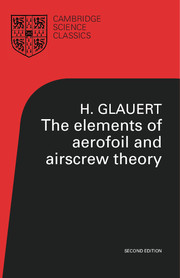Book contents
- Frontmatter
- PREFACE
- PREFACE TO SECOND EDITION
- Contents
- REFERENCES
- Chap. I Introduction
- Chap. II Bernoulli's Equation
- Chap. III The Stream Function
- Chap. IV Circulation and Vorticity
- Chap. V The Velocity Potential and the Potential Function
- Chap. VI The Transformation of a Circle into an Aerofoil
- Chap. VII The Aerofoil in Two Dimensions
- Chap. VIII Viscosity and Drag
- Chap. IX The Basis of Aerofoil Theory
- Chap. X The Aerofoil in Three Dimensions
- Chap. XI The Monoplane Aerofoil
- Chap. XII The Flow round an Aerofoil
- Chap. XIII Biplane Aerofoils
- Chap. XIV Wind Tunnel Interference on Aerofoils
- Chap. XV The Airscrew: Momentum Theory
- Chap. XVI The Airscrew: Blade Element Theory
- Chap. XVII The Airscrew: Wind Tunnel Interference
- Appendix
- Bibliography
- Index
Chap. XII - The Flow round an Aerofoil
Published online by Cambridge University Press: 01 June 2011
- Frontmatter
- PREFACE
- PREFACE TO SECOND EDITION
- Contents
- REFERENCES
- Chap. I Introduction
- Chap. II Bernoulli's Equation
- Chap. III The Stream Function
- Chap. IV Circulation and Vorticity
- Chap. V The Velocity Potential and the Potential Function
- Chap. VI The Transformation of a Circle into an Aerofoil
- Chap. VII The Aerofoil in Two Dimensions
- Chap. VIII Viscosity and Drag
- Chap. IX The Basis of Aerofoil Theory
- Chap. X The Aerofoil in Three Dimensions
- Chap. XI The Monoplane Aerofoil
- Chap. XII The Flow round an Aerofoil
- Chap. XIII Biplane Aerofoils
- Chap. XIV Wind Tunnel Interference on Aerofoils
- Chap. XV The Airscrew: Momentum Theory
- Chap. XVI The Airscrew: Blade Element Theory
- Chap. XVII The Airscrew: Wind Tunnel Interference
- Appendix
- Bibliography
- Index
Summary
The flow pattern.
The deviation of the velocity at any point of the fluid from the undisturbed velocity V is due to the vortex system created by the aerofoil and can be calculated as the velocity field of this vortex system. The general nature of the vortex system, comprising the circulation round the aerofoil and the trailing vortices which spring from its trailing edge, has been discussed in 10·2, and the analysis of chapter XI provides a method of determining the strength of the vortex system associated with any monoplane aerofoil. The analysis is based on the assumption that the aerofoil can be replaced by a lifting line, and calculations based on this assumption will clearly be inadequate to determine the flow in the immediate neighbourhood of the aerofoil where the shape of the aerofoil sections will modify the form of the flow pattern. Also in the neighbourhood of the vortex wake it is necessary to consider the tendency of the trailing vortex sheet to roll up into a pair of finite vortices. Apart from these two limitations it is possible to obtain a satisfactory account of the flow pattern round an aerofoil from the simple assumption of a lifting line and of straight line vortices extending indefinitely down stream.
- Type
- Chapter
- Information
- The Elements of Aerofoil and Airscrew Theory , pp. 156 - 170Publisher: Cambridge University PressPrint publication year: 1983

